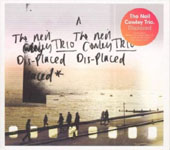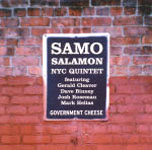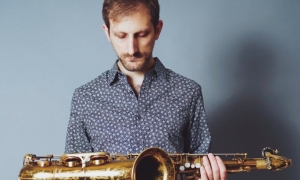Home » Jazz Articles » Interview » Maria Schneider: Fantasies Come True
Maria Schneider: Fantasies Come True
Music is just an expression of life. If you don
 From a certain angle, it would almost appear that composer, arranger extraordinaire Maria Schneider is living in a fantasy world. Her music is highly acclaimed, her performances are killer. The commissions for compositions, conducting and arranging having come steadily, for other musical organizations as well as her own work. Her last recording not only won a Grammy, but is the first recording to do so while being entirely sold over the Internet, at her website, through her association with ArtistShare. The next album to come out in June, titled Sky Blue, by her own admission, might be her band's best yet.
From a certain angle, it would almost appear that composer, arranger extraordinaire Maria Schneider is living in a fantasy world. Her music is highly acclaimed, her performances are killer. The commissions for compositions, conducting and arranging having come steadily, for other musical organizations as well as her own work. Her last recording not only won a Grammy, but is the first recording to do so while being entirely sold over the Internet, at her website, through her association with ArtistShare. The next album to come out in June, titled Sky Blue, by her own admission, might be her band's best yet.
She's worked with her idol, Gil Evans, and over time with some of the finest musicians around. She aimed her life's goal at being able to bring music out of herself and not only form it, but like Geppetto, bring it to life.
And she's done it. Not without blood, sweat and tears along the way. But Maria Schneider, from tiny Windom, Minnesota, stands tall in the jazz music world, rightfully getting plaudits. She's humble and appreciative. But maybe... just maybe... did she see it coming?
- Growing Up With Music
- Moving to New York / Gil Evans
- Striking Out on Her Own
- ArtistShare
- Moving Forward
Growing Up With Music
As a child, "Music was total fantasy to me. I used to sit and play hours on end. We lived in this small town in southwest Minnesota. Very flat. If you looked out the window, you saw a grain elevator in a field and a railroad track down the hill and then the highway, she says with a chuckle. "And a flax plant on the other side of our house. It was what you would call bleak and surreal. But beautiful in its bleakness. We had these big picture windows all around our house. The best part was at night, because of the sky. You could see the whole Milky Way because it was so dark. As I played piano and dove into my music, I used to have a peripheral fantasy that talent scouts were driving on the road and they had radios in their cars and they would be able to hear what I was doing and take me away to New York or something. [laughs].
"Still, to this day a lot of my pieces are related to stories from childhood, people I knew. My music is almost always about something. Here and there, I'll write a piece just based in making music. But a lot of times I express something else.
Even her eventual association with the legendary Gil Evans came about with a mystical bent.

"It was more than a fantasy, because fantasies you sort of drum up. They sort of come of your own mind, says Schneider. "When I was at the University of Minnesota one night I was listening to Gil's music with the lights off. There was a little light coming in. I was looking at this one picture of him... I don't know, I just sort of saw myself working with him. It was weird. I really didn't give a lot of deep thought to it, but it was a significant enough moment that I didn't forget it when it actually happened that I met him and started working for him. I was like, 'Oh my god, I saw this happening.' It was so bizarre.
Okay. What Schneider's life has become isn't something she foresaw. But this artist has perhaps fulfilled some fantasies on her journey through music. Those fantasies are part of the musical fabric of the stories she tells that intoxicate listeners around the globe. But it isn't an easy life for this world-renowned composer and arranger. She is open and honest about it, and intriguing. She's also very genuine, effervescent, and at the same time humble. Down to earth.
She says she's happy, "to be a composer and to have a group and to enjoy the fact that you have an audience. In jazz, to have enough of an audience to pay for a huge group like this, these are the things I'm grateful for. When I started, people told me I was completely insane to even think of doing this. And she is grateful, "that I've had critical acclaim. The critics have been enthusiastic about my music. A lot of musicians don't experience that in their lifetime. They're doing great music and critics don't recognize it.
But traveling the road with her band is a far cry from an easy tasks. The road has laid many a big band to waste over the years.
It's difficult because it's expensive. It's twenty people. What's more difficult than getting the tour is actually doing the tour. I'm coordinating all these musicians. They're all freelance musicians. Trying to get everyone's schedules together when they're hopping all over the globe, each of them with several other groups. Getting the music together. Logistically, it's just an absolute nightmare. Sometimes I'm like, 'Oh god. Why did I start this thing.'
Once on the stage? "Then you forget. Then you make the music and you say, 'Oh, I have to keep doing this.' And sometimes I say, 'Oh, I just want to quit.' Then we make music and I say, 'This is so great.' It's like childbirth. You forget. It's the same thing when I make an album. By the time I finish an album, I'm like: 'I can't ever do that again. Oh my god.' Then it comes out and a couple years later, 'Hmm. Maybe I'll make another album.'
It was a piano teacher in her hometown that first turned Schneider on to the wonders of music; that it wasn't just notes and tunes. She obviously had the spirit in her, so the lesson resonated. Growing up she heard the pop music of the day, but influences came from different area. They continue to do so.
"As a kid, I'd only heard old jazz. I listened to a lot of classical. And the pop of the 60s, like the Fifth Dimension, Simon and Garfunkel, Carol King. In college I started listening to more and more jazz. One of the people that had a big effect on me was Bill Evans, his whole harmonic concept, the beauty of it. Even if he was comping on the piano, he did it very linearly with his left hand. Some piano players when they comp with their left hand, the chords are these structures that just jump all over. He has this incredible voice leading. So I did a lot of transcriptions and stuff of Bill Evans. I learned a lot of harmony from him.

"Gil Evans, I fell in love with, all his music, early and late. I just loved the emotional tone of it. The soloist wasn't just somebody blowing on a chart. There was connectedness between the soloist and the written music. I love that.
She studied music at the University of Minnesota, where she earned a bachelor of music degree in theory and composition. She was classically tilted, but was moved by the likes of Gil Evans, Charles Mingus, Duke Ellington, Thad Jones and George Russell and veered further into jazz. After some study at the University of Miami, she moved on and received a master of music degree in jazz writing from the Eastman School of Music in Rochester, N.Y., and soon ended up in New York City, her home since 1985. For some, the Big Apple might be the polar opposite of a small Midwest town. As with many things, Schneider has the ability to look at things differently. class="f-right"> Return to Index...
Moving to New York / Gil Evans
"If you're going to be in a big city, other than living in a small town like Windom, the closest thing that you'll come to is New York City. Because your neighborhood becomes like your little village. You have a four-block radius where you can find everything you need. The coffee shop, the grocery store, the dry cleaner, the health food store, a few restaurants that you like. And you get to know everybody in those stores. You walk everywhere. You never have to think about going out to your garage, getting in the car and driving someplace. You're right on top of people, so it's like living in a village, she says enthusiastically. "So coming from a small town, New York suits me really well. The other cities I lived in, in between, even if they were wonderful cities like Minneapolis, Miami, Rochester, I didn't get that feeling from those cities. They felt like big cities.
In New York, it was trombonist and famed arranger Bob Brookmeyer that Schneider chose to study from. She also began to work for Evans, which she calls "a fluke, even though that one night she had envisioned it.
"I was a music copyist for eight years in New York. That's how I made my living. Composing in my off time in the evenings, says Schneider. "I was working the Xerox machine and this composer [Tom Pierson] came in and we got talking. We went out for coffee and he asked me who my favorite writer was and I was talking about Gil. Then he called me that night and said, 'I didn't tell you today, but Gil happens to be my best friend. He wants to meet you because he needs somebody to work for him.' So I met Gil and we really hit it off.
"Gil was a very mystical kind of person. For instance, that thing that happened to me in Minnesota. I've told people that and they say, 'Oh, you're psychic.' And I say, 'No, it's not me. It's Gil.' If there was ever a person in my life that I met that would manage to travel through the ether to somebody, she says with a soft laugh, "it would be Gil. Because when we met he, without really knowing that much about what I did, immediately trusted me to do music for him.

With Gil Evans, she worked on various projects with him, including the film The Color of Money, and when Evans' band performed and recorded with pop star Sting in 1987. Such was her relationship with Evans, and her progress and prowess as an arranger, that it was Schneider who was asked by Evans' widow in 1994 to conduct the celebrated arrangements her husband wrote for Miles Davis in the 1950s, including Miles Ahead,, Porgy and Bess and Sketches of Spain at the 1994 Spoleto Festival in Italy and at that year's JVC Jazz Festival in New York City, concerts that helped bring that classic music back into the performance realm.
"I always feel Gil's kind of with me. He actually came to me in a dream once and told me what's like to be dead, she says. "And he gave me everything. He told me all about it. I was completely aware that I was in a dream state and I was talking to Gil. I was asking him things. It was really out. He was unearthly. [laughs] So is his music, the way it reaches people. Miles loved him so. That's because his music has the magic and the 'other side,' in it. He was in touch with something else.
"There was no question about it, for me, she says of her contact with Evans after his death. "As a matter of fact, it was a very, very powerful thing for me. I'd been losing a lot of people I loved, a lot of musicians, people like Mel Lewis, and a woman I was very close with. A lot of people were dying at the same time and I was kind of going through this crisis: Is there nothing? Is there something? And when Gil came to me, it was so obvious that it was real. It wasn't just a dream or a fantasy. I came bounding out of bed in the morning, overjoyed.
"I called his wife [Anita] and I told her. She completely wasn't shocked. She said (calmly), 'Oh, yeah.' It was nothing for her, Schneider recalls with a chuckle. "I thought I'd freak her out. I kind of thought twice about making the phone call: 'Oh my god, Gil came to me and told me this and that!' And she said (calmly), 'Oh yeah.'
"It was an amazing, amazing, amazing opportunity in my life to know Gil Evans.
In addition to studying with Brookmeyer, Schneider was doing a bit of writing for the Mel Lewis Orchestra. Her associations with these musicians helped push her toward her own band. "What I realized is that these men, what I loved about their music, was that it was so uniquely them. I realized if I wanted to find myself, I had to start my own group and make my own music. She adds, "I realized I had to start diving into my own music and finding myself. I thank Gil for inspiring me to do that. And Bob [Brookmeyer] too. At a certain point, too, I didn't want to study with Bob anymore because I realized I needed to start answering some of my own questions. class="f-right"> Return to Index...
Striking Out on Her Own
In the late '80s, she co-led a band with trombonist John Fedchock for a time and in 1993 she struck out on her own. Evanesence (1992) was her first CD, then Coming About (1995) and Allegresse (2000), all on the Enja label. She's also had a very busy life outside her orchestra. She's had numerous commissions and has done writing, arranging and guest conducting for groups around the world. Among those are the Danish Radio Orchestra's commission to arrange and conduct concerts with Toots Thielemans, the Metropole Orchestra, Stuttgart Jazz Orchestra, Orchestre National de Jazz, Carnegie Hall Jazz Orchestra, Monterey Jazz Festival and Jazz at Lincoln Center. Concert in the Garden (ArtistShare, 2004) and Sky Blue (ArtistShare, 2007) resulted from commissions from Hunter College.
"It's amazing that I managed to do this. I have to say it's been to the detriment of having a personal life, she chuckles. "I do nothing else. If you saw my apartment right now, I'm in the process of organizing. I have a small living room. In the middle is a four-drawer file cabinet with a violin on the top. I've got crap all over, from tours, coming and going, the recording. It's just endless. I work really, really hard to keep this thing going.

She notes that toward the end of last year, following a tour, she got sick. "At the end of that tour, I'm thinking I'm going to quit. I can't do this anymore. I just can't keep it up. And then, you know, in bed I kind of rejuvenated and ruminated about the whole thing. Made a couple things in my mind about how I was going to change things. Then in early January, when we finished the album (Sky Blue) I'm like, 'Oh my god, this is my best album yet.' I think everybody was just shocked, because I think none of us expected we would make our best album. We all agreed that we think we did.
"Then all of a sudden, I'm like, 'I can't stop!' Back in the saddle again. But I think I have to maybe do a little less and have some balance. Learning about balance in life is a very difficult thing. But I look at all these people. I don't know that I would say Gil Evans had a balanced life. Maybe this life isn't about balance for me. God only knows. It's a question for Gil. Except he might be on to other things, says Schneider chuckling fondly. "I don't know if he still cares about me enough to come back and tell me the answer to that one. 'Figure that out for yourself, Maria. I'm fine up here. I'm somewhere with Miles.' class="f-right"> Return to Index...
ArtistShare
One of the keys to survival for the hard working composer is ArtistShare.
"That was the key that really turned it around. Honestly, I think I may have quit if I hadn't found that. That thing made it possible for me to record this music and not only pay for my time and pay for the musicians, but make some money, help support what I do. Last year, when I was on the road, I lost $45,000 touring the band. That's how much I go in the hole sometimes, because I'm very often paying the band more than I'm making. And all the expenses that go along with it. If I hadn't had that website, I don't know. The whole thing I'm doing now on the Internet.
"There's no way that would have happened with a record company, I'll tell you that. I was doing nothing but losing and busted my butt trying to make those [previous] records and making nothing. It's really turned my life around.

Through ArtistShare, Schneider says she raised enough to pay for the initial Sky Blue recording costs, including musicians, which was $50,000-plus. It is raised via pre-orders and in high-end purchase offers that give the investor special inside access to the entire process.
"It's amazing... This enables you to really have contact with the people that really do support and pay for your music. Instead of the money going to the record store, the distributor and all the different entities that aren't actually making the music, the money is all coming to me to make the music. The funds are coming to me just to put together these projects. It's very intimate, it's very direct and it's very effective. I'm so happy to do it this way. I would never go back to the old way, she says. class="f-right"> Return to Index...
Moving Forward
So, rejuvenated for the time being, Schneider continues to go about her ways, compiling music that, like Duke Ellington and Charles Mingus, appears to be headed to a very special place. And the young lady isn't done.
"It's just music and stories. To be honest, I don't really go out to hear much jazz anymore, she says of her work. "My whole reason for loving music as a child was like fantasy. It took me away, diving emotionally into the music. To me, so much jazz at a certain period started to become very... I don't know... some musicians, not everybody because there are some really great things [out there]... It felt to me sometimes that a lot of musicians thought in order to do more and to advance their music, it somehow had to become more complex, more cerebral, more interesting. To me, very few people were able to become more complex, cerebral or interesting and also become equally compelling and emotional.
Now it seems to be turning around. A lot of jazz musicians seem to be realizing where jazz was going. It's kind of like a rubber band that stretched and started coming back. They're refining themselves, not so concerned with impressing people.
During the '90s, Schneider began investigating flamenco music, Brazilian music and world music. "I realized that those kinds of music are idioms that came out of culture. They came out of regular people's lives as a means of survival; the alchemy of turning pain into joy, she says. "For that reason, it's infused with human spirit and heart. On top of that, they're coming out of a mix of other things like African music, so the rhythms are incredibly interesting. And the harmonies too. So it is possible to have very intriguing harmony and rhythm, but also have a lot of intensity and spirit in the music.

As for "jazz, Schneider considers herself a musician beyond that term, particularly in the way some musicians stick to the mainstream. "Sometimes in jazz, when I do clinics and things, I talk to young musicians about the fact that a lot of musicians think if they're just in the practice room—practicing, practicing, more and more and more—their music is going to get better and better and they will get more and more like Coltrane or whoever, she says. "I always say music is just an expression of life. If you don't have an interesting life and a life full of passion and interests other than music, you have nothing to say in your music. It doesn't matter how many hours you spend in the practice room. Music is just a means to express something else.
On Schneider's "gratitude list is also, "great family and great friends. And a small town upbringing. I wouldn't trade that for the world, growing up in Windom, Minnesota. It was just the best, she says adding with glee, "Great bird watching, which is one of her other passions. "I love birds.
Sometimes when you talk about your past, you realize all the things and the people who brought you to where you are. Sometimes you don't know when you're going through it. Then you look back and see this winding path and you say, 'Oh my god that person was key and this event was key.' You start to realize what builds your life.
Art like Maria Schneider's is also among those memorable things.
Selected Discography
Maria Schneider Orchestra, Sky Blue (ArtistShare, 2007)
Maria Schneider Orchestra, Days of Wine and Roses (ArtistShare, 2005)
Maria Schneider Orchestra, Concert in the Garden Maria Schneider Orchestra, Allegresse (Enja, 2000)
Maria Schneider Orchestra, Coming About (Enja, 1995)
Maria Schneider Orchestra, Evanescence (Enja, 1992)
Photo Credits
Top Two Photos: Jos L. Knaepen
Third Photo: Hans Kumpf
Bottom Photo: John Abbott
Tags
About Maria Schneider
Instrument: Composer / conductor
PREVIOUS / NEXT
Maria Schneider Concerts
Support All About Jazz
 All About Jazz has been a pillar of jazz since 1995, championing it as an art form and, more importantly, supporting the musicians who make it. Our enduring commitment has made "AAJ" one of the most culturally important websites of its kind, read by hundreds of thousands of fans, musicians and industry figures every month.
All About Jazz has been a pillar of jazz since 1995, championing it as an art form and, more importantly, supporting the musicians who make it. Our enduring commitment has made "AAJ" one of the most culturally important websites of its kind, read by hundreds of thousands of fans, musicians and industry figures every month.





















